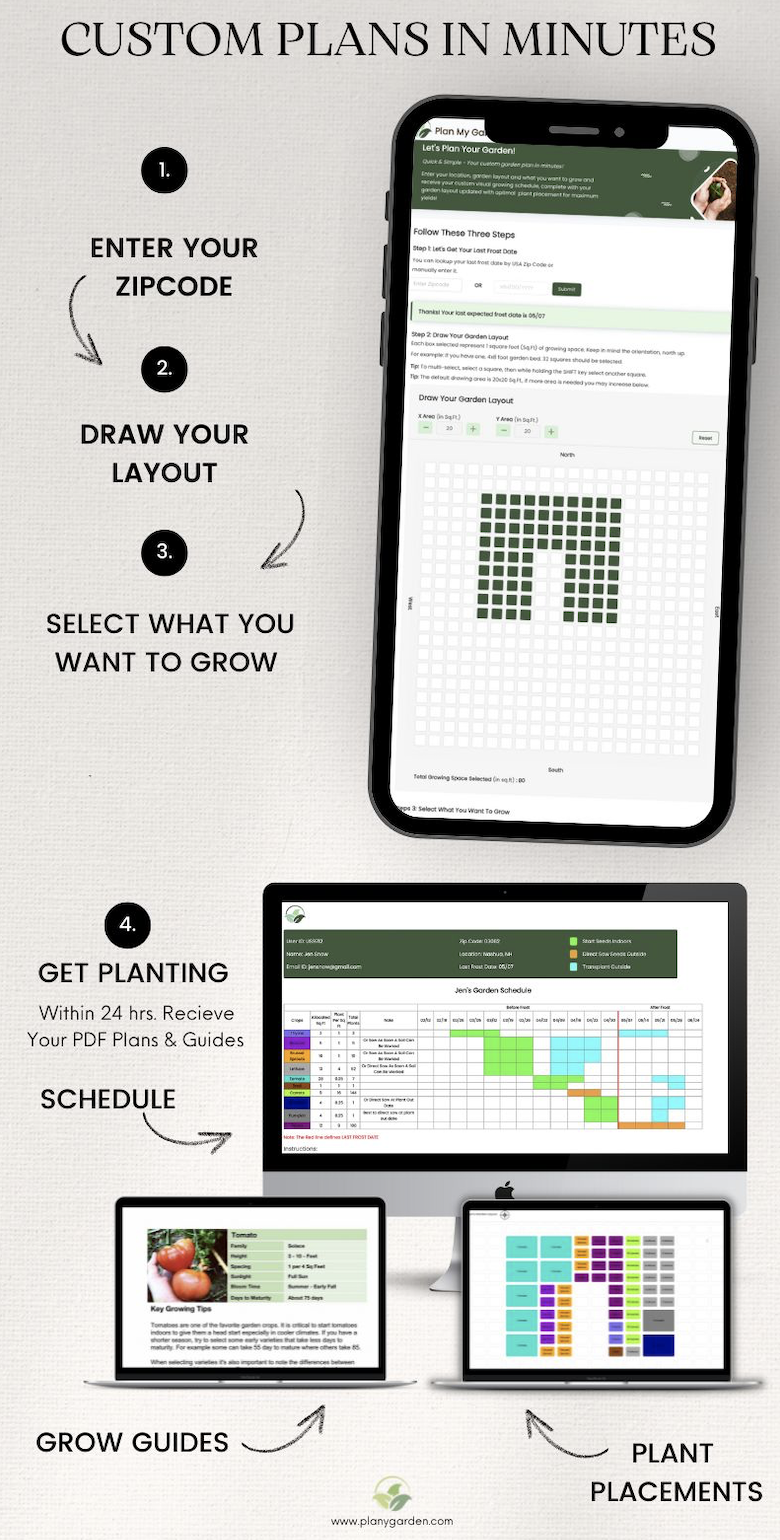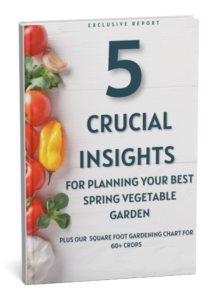Last Updated on April 17, 2024
The Ultimate Guide to Successfully Planting and Growing Potatoes in Your Garden
Are you ready to dig into the world of potato gardening? Whether you’re a seasoned gardener or just getting started, this ultimate guide will transform your garden into a potato paradise. In this guide, we’ll walk you through the entire process of planting and growing potatoes, from selecting the right potato variety to harvesting your bountiful crop.
With our expert tips and step-by-step instructions, you’ll learn all the secrets to successfully growing potatoes in your garden. Discover the ideal planting time, the best soil conditions, and essential care techniques to ensure healthy plants and a plentiful harvest. We’ll even share some innovative methods for growing potatoes in containers or in small spaces.
So get ready to roll up your sleeves and get your hands dirty because it’s time to plant and grow your very own potatoes. With this ultimate guide in your arsenal, you’ll have all the knowledge and tools you need to cultivate a thriving potato garden. Let’s get started and transform your backyard into a potato paradise!
Benefits of growing potatoes in your garden
Potatoes are a versatile and nutritious staple in many diets around the world. Planting and Growing Potatoes on your own not only ensures a supply of fresh, organic produce but also offers numerous benefits for you and your garden.
Firstly, growing potatoes allows you to select from a wide variety of flavors and textures that may not be readily available in grocery stores. You can experiment with different types of potatoes, from buttery Yukon Golds to creamy fingerlings, and discover your personal favorites.
Furthermore, cultivating potatoes in your garden can lead to cost savings. Potatoes are relatively inexpensive to grow, and with the right techniques, you can produce a substantial amount of potatoes from just a few seed potatoes. This can be especially beneficial if you have a large family or enjoy cooking with potatoes regularly.
Lastly, planting and growing potatoes can improve the health of your garden soil. Potatoes are known as “green manure” because they improve soil structure and add organic matter. Their extensive root systems help break up compacted soil, making it more suitable for other plants. By incorporating potatoes into your crop rotation, you can naturally enrich your soil and reduce the need for synthetic fertilizers.
In summary, growing potatoes in your garden offers the advantages of variety, cost savings, and soil improvement. It’s a rewarding experience that allows you to enjoy fresh, flavorful potatoes while enhancing the health and productivity of your garden.
Types of potatoes to grow
When it comes to choosing which potatoes to grow in your garden, the options can seem overwhelming. There are countless varieties, each with its own unique characteristics and culinary uses. Here are some popular types of potatoes to consider when planting and growing potatoes.
1. Russet Potatoes: Russets are well-known for their high starch content, which makes them perfect for baking, mashing, and frying. They have a fluffy texture and a mild, earthy flavor. Russets are also excellent for making crispy homemade French fries.
2. Yukon Gold Potatoes: Yukon Golds have a buttery, golden flesh and a thin, delicate skin. They are versatile and can be used for boiling, baking, roasting, and mashing. Yukon Golds have a creamy texture and a slightly sweet, nutty flavor.
3. Red Potatoes: Red potatoes have a waxy texture and a thin, red skin. They are ideal for boiling, steaming, and roasting, as they hold their shape well. Red potatoes have a slightly sweet and creamy taste that complements a variety of dishes.
4. Fingerling Potatoes: Fingerlings come in different colors, including yellow, red, and purple. They have a small, elongated shape and a firm, waxy texture. Fingerlings are great for roasting, grilling, or using in salads, as they retain their shape and have a rich, nutty flavor.
5. Purple Potatoes: Purple potatoes have a vibrant, deep purple skin and flesh. They are visually striking and can add a pop of color to your meals. Purple potatoes have a slightly sweet and earthy flavor, making them great for roasting, mashing, or using in salads.
When selecting potato varieties, consider your personal preferences and the culinary uses you have in mind. It’s also worth noting that some varieties perform better in certain climates or soil conditions than others. Research the characteristics of different potato types and choose ones that suit your growing conditions and taste preferences.
Here in NH when planting and growing potatoes, we found that Yukon Gold does wonderful in our climate.
Now that you have an idea of the types of potatoes available, it’s time to move on to selecting the right location for your potato garden.
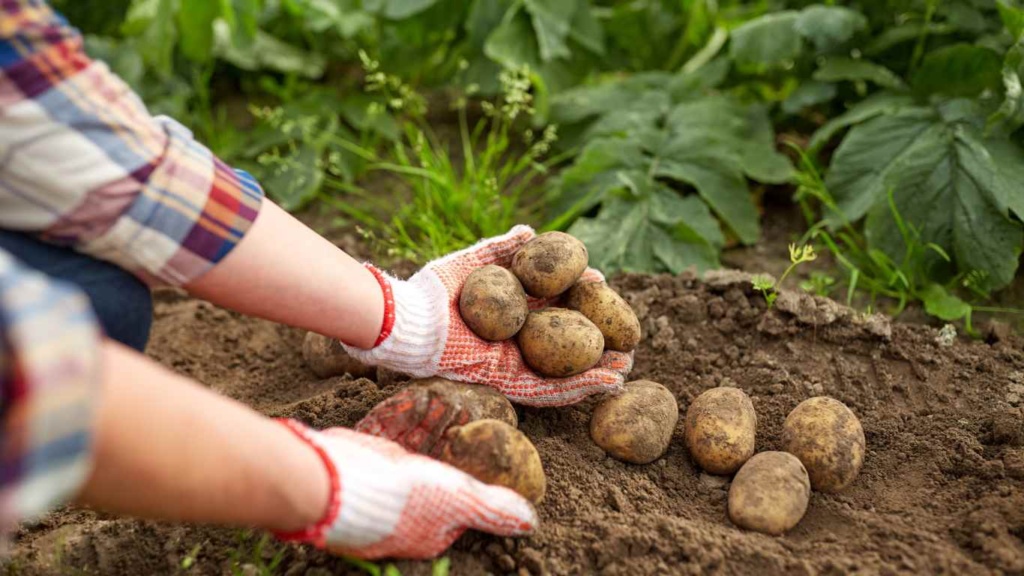
Choosing the right location for your potato garden
The success of your potato garden depends largely on selecting the right location. Potatoes thrive in well-drained soil and require a good amount of sunlight to grow and develop. Here are some factors to consider when choosing a location for your potato garden:
1. Sunlight: Potatoes need at least six to eight hours of direct sunlight each day to produce a healthy crop. Choose a spot in your garden that receives ample sunlight throughout the day, especially during the morning and early afternoon. Make sure that your potato plants are positioned so they don’t overshadow other plants in your garden, and also ensure they aren’t shaded by taller vegetables. For optimal garden layout and plant spacing, consider using our “Plan My Garden” service.
2. Soil Drainage: Potatoes prefer well-drained soil to prevent waterlogging, which can lead to rot and disease. Avoid low-lying areas or heavy clay soils that tend to retain moisture. If your soil is heavy or poorly drained, consider creating raised beds or mounds to improve drainage.
3. Soil pH: Potatoes thrive in slightly acidic to neutral soil, with a pH range of 5.0 to 7.0. Test your soil’s pH using a soil testing kit or by sending a sample to a local agricultural extension office. If your soil pH is too acidic, you can amend it with lime. Conversely, if it’s too alkaline, you can add sulfur or organic matter to lower the pH.
4. Proximity to Water: Potatoes require regular watering, especially during dry periods. Choose a location that is conveniently close to a water source, such as a hose or irrigation system. This will make it easier to provide consistent moisture to your potato plants.
Once you’ve identified a suitable location for your potato garden, it’s time to prepare the soil for planting.
Preparing the soil for planting and growing potatoes
Preparing the soil is an essential step in setting the stage for successful potato growth. Proper soil preparation ensures that your potato plants receive the necessary nutrients, moisture, and oxygen for healthy development. Here’s how to prepare your soil for planting potatoes:
1. Clear the area: Remove any weeds, rocks, or debris from the planting area. Weeds can compete with your potato plants for nutrients and water, so it’s important to start with a clean slate.
2. Loosen the soil: Use a garden fork or a tiller to loosen the soil to a depth of at least 12 inches. This helps improve drainage and allows the potato roots to penetrate the soil easily. Avoid over-tilling, as it can lead to soil compaction and poor drainage.
3. Amend the soil: Potatoes thrive in fertile soil that is rich in organic matter. Incorporate well-rotted compost, aged manure, or other organic amendments into the soil to improve its nutrient content and structure. Work the amendments into the top 6 to 8 inches of soil.
4. Level the soil: Rake the soil surface to create a level planting bed. This ensures even moisture distribution and facilitates proper tuber formation. Remove any large clumps or rocks that could hinder root growth or cause irregularities in the potato bed.
By following these soil preparation steps, you provide your potato plants with a healthy growing environment that sets the stage for a successful harvest. Now it’s time to move on to planting and spacing your potatoes.
Spacing When Planting and Growing Potatoes
Proper planting and spacing are crucial for healthy potato growth and a plentiful harvest. The spacing between potato plants allows for adequate air circulation, reduces the risk of disease, and ensures that each plant has enough space to develop tubers. Here’s how to plant and space your potatoes:
1. Cutting Seed Potatoes: Start by selecting high-quality seed potatoes from a reputable source. Seed potatoes are specially grown for planting, and they should be free from diseases and have at least one or two “eyes” or buds. If the seed potatoes are large, you can cut them into smaller pieces, making sure each piece has at least one bud. Allow the cut pieces to dry for a day or two before planting to prevent rotting.
2. Planting Depth: Dig a trench or individual holes for planting your seed potatoes. The ideal planting depth is around 4 to 6 inches. Place the seed potatoes in the trench or hole with the eye facing up. Space the potatoes 12 to 15 inches apart within the row and leave 2 to 3 feet between rows. This spacing allows the plants to receive adequate sunlight and prevents overcrowding. If you are planning in a square foot garden you can do 1 seed potato per square foot, see our square-foot gardening chart here.
3. Hilling: After planting, cover the seed potatoes with soil, leaving a small mound or hill on top. As the plants grow, continue to add soil or mulch around the base of the plants to create a hill. Hilling helps prevent the tubers from being exposed to sunlight, which can cause them to turn green and become toxic. It also provides more soil for the potatoes to grow and increases the potential yield.
4. Container or Small Space Planting: If you have limited space or lack a traditional garden bed, you can still grow potatoes in containers or small spaces. Choose a large container or grow bag with drainage holes and fill it with a well-draining potting mix. Plant one or two seed potatoes per container, ensuring that there is enough space for the plants to grow. As the potatoes grow, continue to add soil or mulch to the container, similar to the hilling method. Container-grown potatoes may require more frequent watering and fertilization compared to those grown in the ground.
By following these planting and spacing guidelines, you provide your potato plants with the necessary room to grow and develop healthy tubers. Now let’s move on to caring for your potato plants to ensure optimal growth and productivity.

Caring for potato plants – watering, fertilizing, and pest control
Proper care is essential for the health and productivity of your potato plants. From watering to fertilizing and pest control, here are the key aspects of caring for your potato plants:
1. Watering: Potatoes require consistent moisture throughout the growing season, especially during tuber formation. Aim to keep the soil evenly moist, but not waterlogged. Overwatering can lead to rot and disease, while underwatering can result in small, misshapen tubers. Water deeply once or twice a week, depending on rainfall and soil conditions. Mulching around the plants helps conserve moisture and suppresses weed growth.
2. Fertilizing: Potatoes benefit from a balanced fertilizer application to ensure they receive adequate nutrients for growth. Before planting, incorporate a slow-release organic fertilizer or compost into the soil. This provides a gradual nutrient release over the growing season. Avoid using excessive nitrogen, as it can encourage lush foliage growth at the expense of tuber development.
3. Pest Control: Several pests can affect potato plants, including potato beetles, aphids, and nematodes. Monitor your plants regularly for signs of pest damage, such as chewed leaves or yellowing foliage. Handpick and destroy any pests you find, or use organic pest control methods such as neem oil or insecticidal soap. Crop rotation can also help reduce pest populations by interrupting their life cycle. Avoid planting potatoes in the same location or near other nightshade family plants for consecutive years.
4. Disease Prevention: Potatoes are susceptible to various fungal and bacterial diseases, including late blight and early blight. To prevent these diseases, choose disease-resistant potato varieties whenever possible. Practice good garden sanitation by removing and destroying any infected plant debris. Avoid overhead watering, as it can promote disease spread. If necessary, apply organic fungicides or bactericides according to the manufacturer’s recommendations.
By providing adequate water, nutrients, and protection against pests and diseases, you ensure that your potato plants thrive and produce a bountiful harvest. Now, let’s move on to the exciting part – harvesting and storing your homegrown potatoes.
Harvesting and storing potatoes
The moment you’ve been waiting for has arrived – it’s time to harvest your homegrown potatoes! Harvesting at the right time ensures that your potatoes have reached their maximum size and flavor. Here’s how to harvest and store your potatoes:
1. Harvest Timing: Potatoes are typically ready for harvest when the plants have flowered and the foliage starts to yellow and die back. This usually occurs around 10 to 12 weeks after planting, but it can vary depending on the potato variety and growing conditions. To check if the tubers are ready, gently dig around the base of a plant and feel for the presence of mature potatoes.
2. Harvesting Technique: To harvest your potatoes, use a garden fork or shovel to carefully lift the plants from the soil. Start digging at least 6 inches away from the plant to avoid damaging the tubers. Lift the plants gently, being careful not to puncture or bruise the potatoes. Shake off excess soil and remove any damaged or diseased potatoes.
3. Curing: After harvesting, allow the potatoes to cure for a week or two in a cool, dark, and well-ventilated area. Curing helps toughen the skin and heal any minor wounds, improving their storage quality. Spread the potatoes in a single layer on newspaper or a wire rack, avoiding direct sunlight.
4. Storage: Once the potatoes have cured, it’s time to store them for long-term use. Choose a cool, dark, and humid storage location, such as a basement or cellar. Keep the potatoes in breathable containers, such as burlap sacks or mesh bags, to promote air circulation and prevent moisture buildup. Check the stored potatoes regularly and remove any sprouting or rotting tubers to prevent spoilage.
By following these harvesting and storage tips, you can enjoy the fruits of your labor for months to come. Now let’s discuss some common mistakes to avoid when growing potatoes to ensure your success as a potato gardener.
Common mistakes to avoid when planting and growing potatoes
Growing potatoes can be a rewarding experience, but it’s important to avoid common mistakes that can hinder your success.
Here are some pitfalls to watch out for:
Improper soil preparation, planting too early when the soil is too cold, planting pieces without eyes, overcrowding plants, insufficient watering, neglecting to mound soil around plants, and ignoring pests and diseases.
It’s also important not to harvest too soon; patience is key for a full crop.
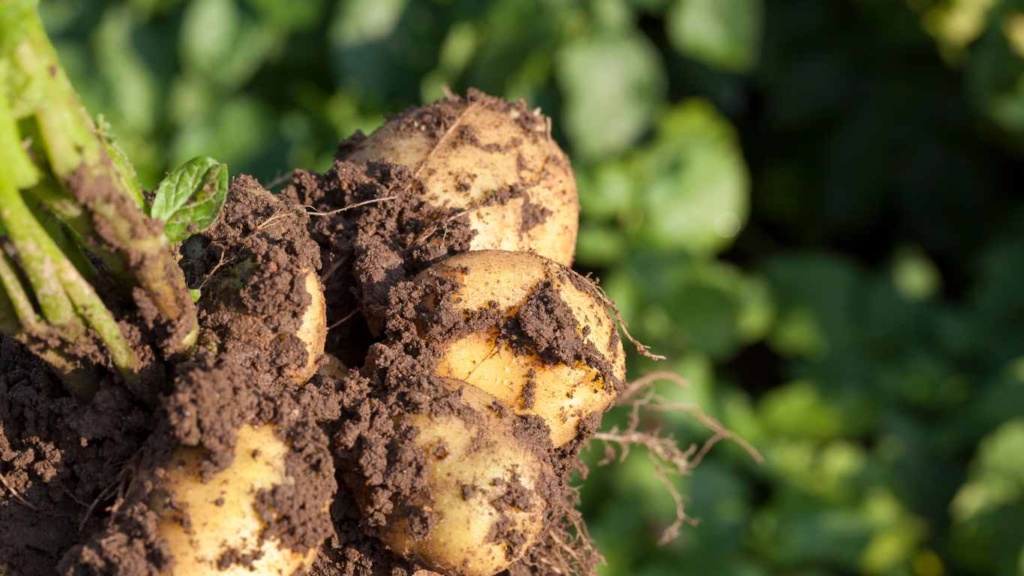
Conclusion and final tips for successful potato gardening
Congratulations! By following this ultimate guide, you’ve learned all the secrets to planting and growing potatoes, from selecting the right variety to harvesting your bountiful crop.
Remember, potato gardening requires patience, care, and attention to detail. Ensure that your potatoes receive proper watering, fertilization, and care throughout the growing season. Protect them from pests and diseases by monitoring your plants regularly and taking appropriate action.
Experiment with different potato varieties and growing techniques to find what works best for you. Whether you have a large backyard or a small balcony, there are innovative methods for growing potatoes in containers or in small spaces.
So go ahead, dig in, and enjoy the delicious taste of homegrown potatoes. With the knowledge and tools gained from this ultimate guide, you’ll be able to cultivate a thriving potato garden year after year. Happy gardening!
Remember, every garden has its unique challenges and opportunities, so experiment with different techniques and varieties to discover what works best for you. Happy gardening, and don’t forget to check out Tim’s other videos for more gardening inspiration and advice.
And for those planning their spring garden, check out PlanMyGarden, which makes garden planning simple. Enter your ZIP code, draw your garden layout, and select what vegetables to grow. We’ll send you a custom PDF with schedules, guides, and optimal plant placements for maximum yields.
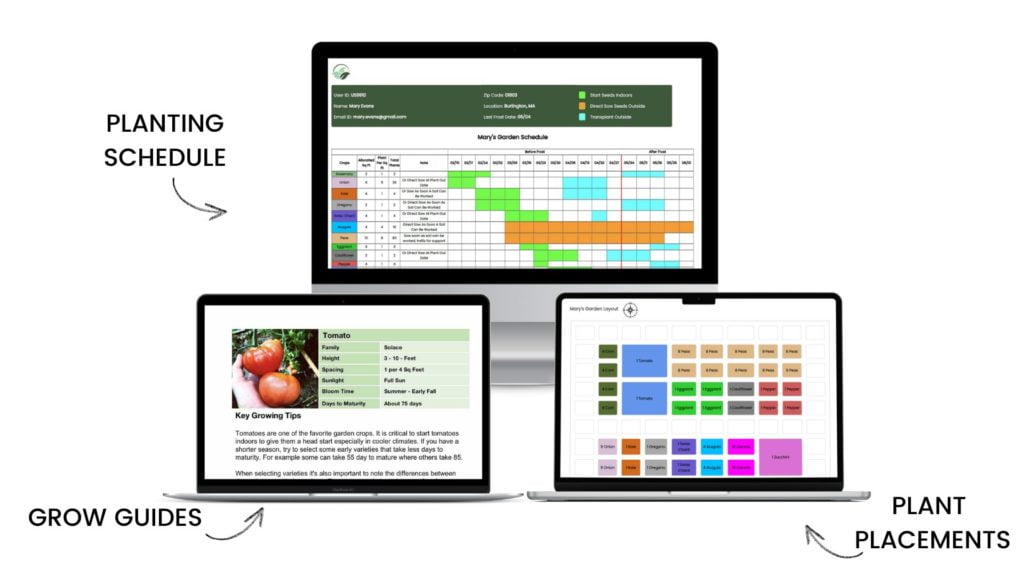
Stay tuned for our next post, and happy gardening!

